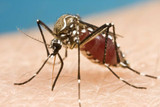Mozzies on the increase in parts of NSW as rain, tides roll in after dry summer
If you think you have been seeing or feeling more mozzies lately, you are not imagining it — the pests are thriving in parts of New South Wales.
Key points:
- Recent rain and high tides have provided the ideal conditions for mosquito numbers to boom
- Experts are warning people not to be complacent about mosquitos protection and avoidance
- Mosquitos can pass on diseases they have picked up from birds and animals
The most recent NSW Arbovirus Surveillance and Mosquito Monitoring Report found a high number of mosquitoes had been detected in Port Macquarie, Griffith, in the Riverina, and in Parramatta, in western Sydney.
A very high number of mozzies was also detected at Georges River, in the Bankstown area.
"Even though we've had a really hot and dry summer, we've also just recently had a lot of rain," said medical entomologist with NSW Health Pathology, Cameron Webb.
"We've also had some high tides inundate and flood some of our coastal wetlands and mosquitoes have responded to that really well.
Surging with the tide
Dr Webb expects the blood-sucking insects will be around for at least a few weeks.
"Mosquitoes don't live very long — maybe no more than about three weeks — so in a fortnight or so, you will start to see a steady decline in mozzie numbers," he said.
"The bad news, I guess, is that we've got another series of big tides expected in early February so as soon as these mosquitoes start to disappear, we'll probably get another surge in mozzies, kind of in the middle of February or towards the end of that month.
The report said high tides between February 8 and 12 could trigger the hatching of Aedes vigilax mosquitoes.
There is some good news
Despite the increase in mosquito numbers, the report found the prevalence of cases of Ross River virus in humans remained low, with Barmah Forest virus notifications similar to previous years.
Neither virus had been detected in mosquitoes collected at a number of sites across the state.
Greg Bell, acting director of the North Coast Public Health Unit which covers an area from Camden Haven to the Queensland border, said it meant mosquitos were currently more of a nuisance than a health threat.
"NSW Health has a program that local authorities and other groups are involved with where we actually trap the mosquitoes and send them away to be checked," he said.
"They look for the actual viruses … such things as Ross River and Barmah Forest.
Bites not worth associated risk
Despite viruses not being detected in mosquitoes, experts are still warning people to avoid being bitten.
"Mosquitoes, people need to realise, are vectors," Mr Bell said.
"That means they pass on disease from the host — the hosts are things such as waterfowl and marsupials and other things like that.
"[Diseases not being detected] can simply mean that some of these waterfowl haven't moved back or they're in another area.
"Once you get numbers of mosquitoes, what we're saying to people is just start to realise that they can be a health hazard.
"The message to people is that once the mosquitoes are there, just because at present we're not finding disease, when people are bitten by mosquitoes, they could actually start to pick up disease."
Just one mozzie
Dr Webb said it would be more likely to see mosquito-borne disease towards the end of summer and into early autumn.
"Even if you're out and about and you don't think you're bothered too much by mosquitoes, please take steps," he said.
"Wear repellent, cover up when you can if you're outdoors near the wetlands and bushland areas at dawn and dusk when mosquitoes are active.
When virus are circulating, it only takes one mosquito bite to pass on the pathogens that can make you sick."
Recent Posts
-
Dengue fever deaths surge in Caribbean and Americas due to climate crisis
Warmer weather brought on by climate crisis enables mosquitoes that carry virus to expand their reac …12th Dec 2024 -
5 Benefits of Using Bed Canopy Mosquito Nets for Your Bedroom | MosquitoNets.com
5 Benefits of Using Bed Canopy Mosquito Nets for Your BedroomLooking for a simple yet elegant solut …20th Nov 2024 -
Novel way to beat dengue: Deaf mosquitoes stop having sex
Scientists believe they have found a quirky way to fight mosquito-spread diseases such as dengue, ye …7th Nov 2024




